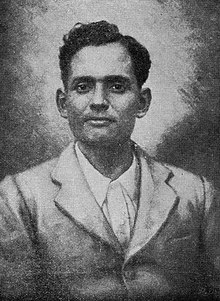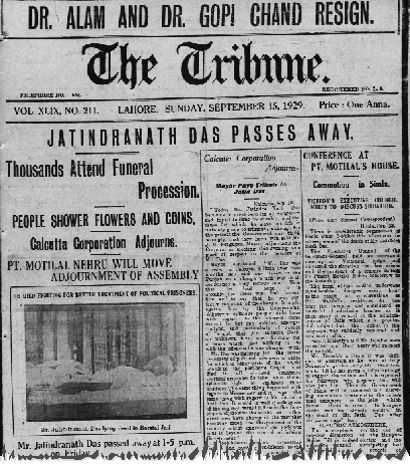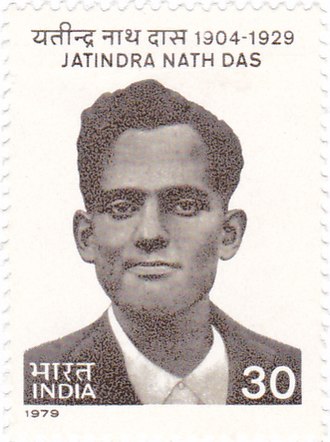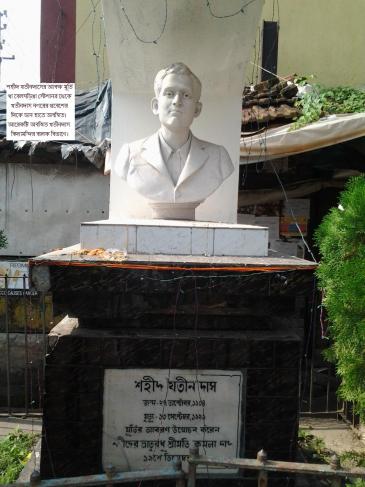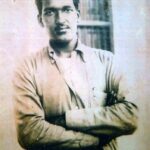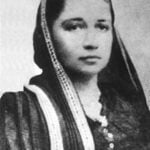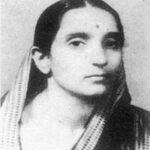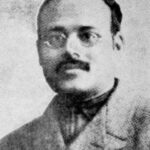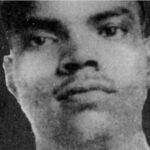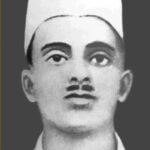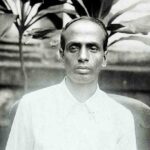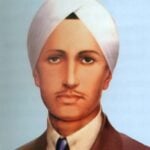Jatindra Nath Das Age, Death, Wife, Family, Biography & More
| Bio/Wiki | |
|---|---|
| Nickname | Jatin [1]The Tribune |
| Profession | Freedom Fighter |
| Known for | • Following a 63-day hunger strike in jail • Participating in the non-cooperation movement |
| Physical Stats & More | |
| Eye Colour | Black |
| Hair Colour | Black |
| Personal Life | |
| Date of Birth | 27 October 1904 (Thursday) |
| Birthplace | Calcutta, Bengal Presidency, British India |
| Date of Death | 13 September 1929 |
| Place of Death | Lahore, Punjab, British India (present-day Punjab, Pakistan) |
| Age (at the time of death) | 24 Years |
| Death Cause | Hunger strike [2]The Wire |
| Zodiac sign | Scorpio |
| Nationality | British Indian |
| Hometown | Calcutta, Bengal Presidency, British India |
| College/University | Vidyasagar College, Calcutta, India |
| Educational Qualification | BA from Vidyasagar College, Calcutta, India [3]India Today |
| Relationships & More | |
| Marital Status (at the time of death) | Unmarried |
| Family | |
| Wife/Spouse | N/A |
| Parents | Father- Bankim Behari Das Mother- Suhashini Das |
| Siblings | Younger Brother- Kiron Das |
Some Lesser Known Facts About Jatindra Nath Das
- Jatindra Nath Das was an Indian activist and revolutionary freedom fighter. He was an active member of the Hindustan Socialist Republican Association and participated in several Indian freedom fighting movements. He died at the age of 29 in Lahore jail after fighting for India’s independence following a 63-days hunger strike.
- Jatindra Nath belonged to a middle-class family in Calcutta. He was a bright student and completed his matriculation studies in the first division. Soon after finishing his school studies, Jatindra Nath Das joined a revolutionary group in Bengal named Anushilan Samiti. At the age of seventeen, Jatindra Nath Das actively participated in the non-cooperation movement, which was started by Mahatma Gandhi in 1921.
- Later, Jatindra Nath Das attended Bangabasi College in Calcutta, where he pursued a Bachelor of Arts degree. In November 1925, he was detained by the British police for his involvement in political activities and was sent to Mymensingh jail. During his stay in jail, Jatindra Nath Das experienced the ill-treatment provided to the political prisoners in jail and went on a hunger strike to protest against the same. The superintendent of jail apologised to Jatindra Nath Das after twenty days of his fast, and soon, Jatindra Nath gave up the fast. Later, Jatindra Nath Das learned how to make bombs from a renowned revolutionary Sachindra Nath Sanyal. [4]Filming Reality
- Jatindra Nath Das was again detained by British police on 14 June 1929 under the charges of his involvement in the Lahore Conspiracy Case. In the Lahore jail, he began another hunger strike and demanded equal treatment with Indian political prisoners and Europeans. Jatindra Nath Das was upset with the miserable conditions of Indian prisoners in the jail. The Indian prisoners used to wear dirty uniforms that were not washed for several days and various rats and cockroaches were often spotted around the kitchen area making the food of Indian prisoners unhygienic to eat. The reading and writing papers to Indian prisoners were also not provided by the British authorities. However, the prisoners who were of British origin were provided with first-class facilities.
- Jatindra Nath Das began his hunger strike on 13 July 1929. During his hunger strike, Jatindra Nath Das was brutally beaten up by the British authorities, who tried to force-feed him when Jatindra Nath was on a hunger strike. His lungs were damaged and paralysis began spreading to various parts of his body. Consequently, he was released by the jail authorities; however, the British government rejected his unconditional release and released him on bail.
- On 12 September 1929, Muhammad Ali Jinnah delivered a speech, a day before the martyrdom of Jatindra Nath Das. Jinnah said,
The man who goes on hunger-strike has a soul. He is moved by that soul and he believes in the justice of his cause.”
- After 63 days of hunger strike, Jatindra Nath Das died on 13 September 1929. The well-known Indian freedom fighter Durgawati Devi led his funeral procession from the Lahore jail to Calcutta. This funeral procession was attended by thousands of Indians by train. In Calcutta, Jatindra Das’ coffin was received by Subhash Chandra Bose at Howrah railway station, and it was carried two-mile-long to the cremation ground.
- Reportedly, his funeral procession was considered one of the biggest gatherings in Kanpur, which was led by Durgawati Devi, along with Ganesh Shankar Vidyarthi and Jawaharlal Nehru, and in Allahabad, it was led by Kamla Nehru.
- Soon after his death, the then Viceroy of India informed London that –
Mr. Das of the Conspiracy Case, who was on hunger strike, died this afternoon at 1 p.m. Last night, five of the hunger strikers gave up their hunger strike. So, there are only Bhagat Singh and Batukeshwar Dutt who are on strike.”
- The hunger strike initiated by Jatindra Das in Lahore jail was an important moment that motivated other freedom fighters to battle against the illegal detentions by the British government.
- After the death of Jatindra Das, the Punjab Legislative Council leaders Mohammad Alam and Gopi Chand Bhargava resigned from their positions to protest against the death of Jatindra Nath Das. Soon, the Central Assembly was adjourned by Motilal Nehru to protest against the ill-treatment provided to the Lahore prisoners. Jawaharlal Nehru stated on the death of Jatindra Nath Das that India would get Independence soon after experiencing such martyrdom. He said,
Another name has been added to the long and splendid roll of Indian martyrs. Let us bow our heads and pray for strength to act to carry on the struggle, however long it may be and whatever consequences, till the victory is ours.”
- Subhash Chandra Bose considered Jatindra Nath Bose as Dadhichi of India. Dadhichi was a renowned mythological yogi who sacrificed his life for killing a demon.
- The British Empire was forced to change its policy of handing over the bodies of Indian freedom fighters to their family soon after a photograph of Jatin’s dead body was printed in The Tribune newspaper in 1929. This photograph almost shook the souls of the Indian people.
- Kama Maclean, an associate professor of South Asian and World History at the University of New South Wales, Australia, stated in her book “A Revolutionary History of Interwar India” that nationalist politics was greatly affected by the death of Jatindra Nath Das. She wrote,
Das’ death created a major impact on nationalist politics, as indicated on the first page of The Tribune. After this, the British stopped handing over bodies of revolutionaries to their kin.”
She added that Jatindra Nath Das’ body was handed over to his kins after his death, but his funeral procession caused a sensation in the media. She wrote,
Jatin Das’ body was given to family, but the Bengal Congress took responsibility to repatriate him back to Bengal. The train stopped at major stations and the body was viewed by many. It caused a sensation in the press and all the way back to Calcutta.”
- Kiron Das, the younger brother of Jatindra Nath Das, was allowed to stay with him during Das’ hunger strike so that he could take care of him.
- A book titled “Profile of Martyr Jatin Das” states that the photo of the dead body of Jatin Das was clicked at the entrance of the Lahore jail on the evening of 13 September 1929. [5]The Tribune India It read,
After the photo of the dead hero was taken, the bier was bedecked with garlands and flowers. Jatin’s body was buried under a pile of flowers which were wet with scented water. Reclining on the big pillow was his head a mere skull. The bloodless face with the sunken cheeks and eye-balls deep down in the sockets bore traces of the death agony. It was easy to see that he had perished inch-by-inch.”
- During his funeral procession, not even a single shop was open from Lahore to Calcutta. People showered coins on his dead body, and some people were spotted picking up those coins and heard saying that they would use the coins as ornaments for their children.
- Shiv Verma, who was one of the companions of Jatindra Nath Das, mentioned the nature of Jatindra Nath in his book Samsmritiyan. Shiv Verma said that Jatindra Nath Das was a serious-looking, sound, and soft-spoken person.
- During his detention period and hunger strike, Jatindra Das neither followed the advice of doctors nor accepted their medicines. Even, the noted Congress leaders tried hard to convince him. Later, he took medicines on the advice of Bhagat Singh. Once, when Jatindra was asked why he always obeyed the advice of Bhagat Singh, he replied,
You know not how brave he is! I can never refuse his offerings.”
- Reportedly, before starting his hunger strike, Jatindra Nath Das told his companions that the hunger strike was a battle against the British empire in India and that inch by inch death was more difficult than dying on the gallows. Jatindra Nath Das said,
By declaring this hunger strike, we are jumping into a battle that will be hard to fight, harder even than gunfight. Creeping towards death inch by inch is more difficult than meeting death by the bullet or dying on the gallows. It will be against the dignity of revolutionaries to step back after jumping into the struggle. It is better not to join the struggle, than taking yourself back in the midway.”
- In 1979, the Government of India issued a postal stamp with the name and picture of Jatindra Nath Das printed on it.
- In the 2002 Bollywood film ‘The Legend of Bhagat Singh,’ Jatindra Nath Das’s character was portrayed by Indian actor Amitabh Bhattacharjee.
- In 2009, a documentary film titled ‘Immortal Martyr Jatin Das’ was released, and it was a thirty-five minutes story that picturised the sacrifice of Jatindra Nath Das for his countrymen.
- Later, a statue was erected at Jatindradas Nagar in West Bengal in memory of Jatindra Nath Das and to honour his sacrifices for the independence of India.
- ‘How Empire Mattered: Imperial Structures and Globalization in the Era of British Imperialism’ – a research paper that studied the lives of the hunger strike victims and the behaviour of the British toward under-trial prisoners concluded in their analysis that the colonial government kept thousands of revolutionaries in jail without trials. It studied,
The hunger strike by Jatin Das in 1929 that resulted in his death was one crucial moment in the resistance against illegal detentions; hunger strikes in Deoli in 1932 and the Andaman Islands in 1934 and 1937 further exacerbated the public relations problem that the colonial government faced in justifying why they were keeping thousands in jail without trials.”
References/Sources:

